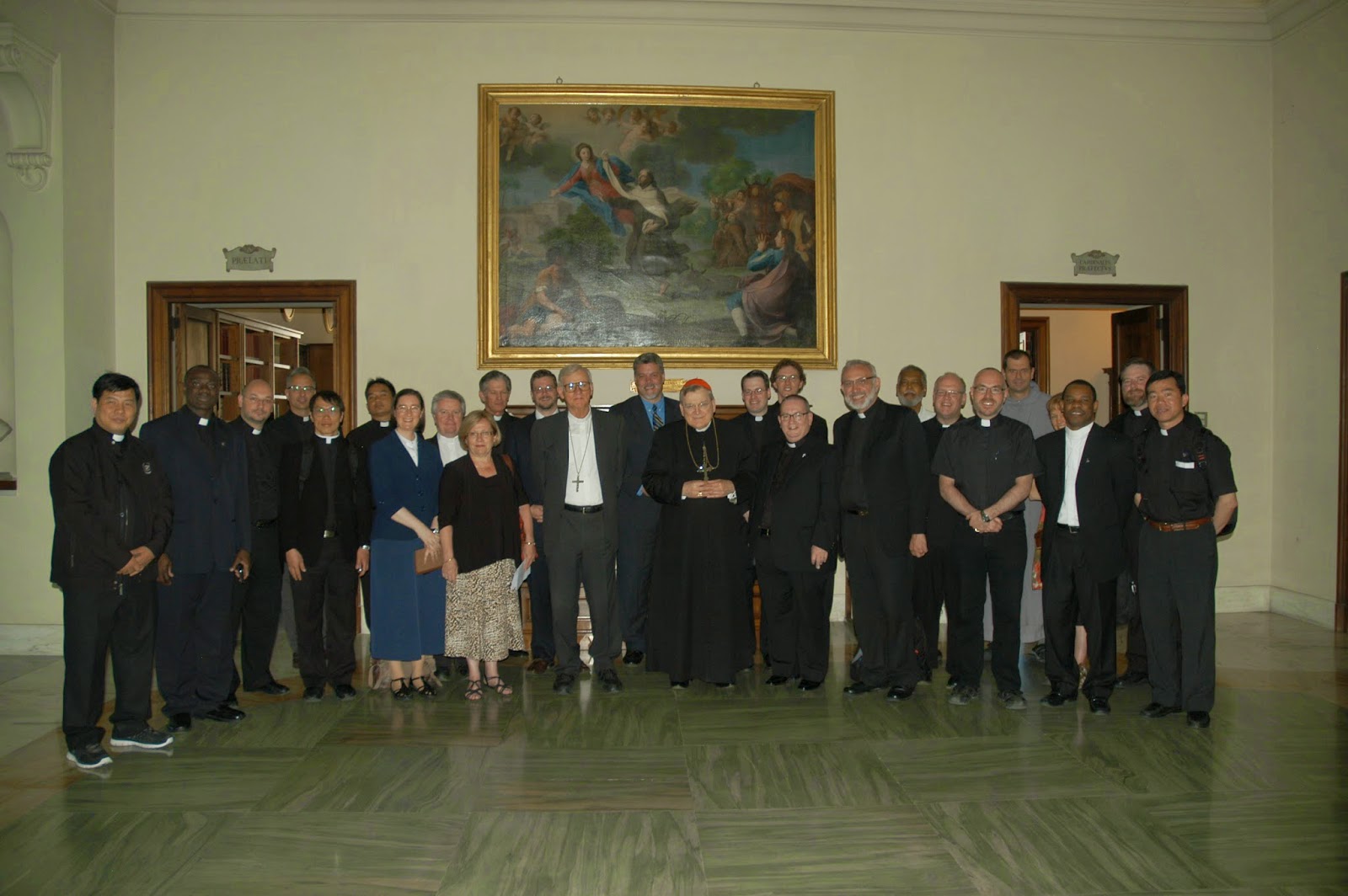All roads lead to Rome!
 | ||
| Our group with Cardinal Raymond Burke, Prefect of the Supreme Tribunal of the Apostolic Signatura |
From Ottawa to Dublin, from Dublin to Rome, all the roads were leading towards Rome for the JCL students of Saint Paul University. For some, it was the final two weeks of the JCL programme, having just completed comprehensive exams that same week. I travelled from Toronto to Dublin as one of our sisters was seriously ill and preparing to go home to God. The following day I went to Rome to meet up with the rest of my classmates who were already gathered there since the weekend and were enjoying the whole Roman experience including the sunshine and the warm temperatures. After such a long winter in Ottawa with snow until mid-May, it was a welcome change!
I was happy to return to Casa Madre Scolastica, our international student house, which I would be calling home for the next two weeks. I had lived there previously during my last stay in Rome so it was good to see familiar faces and also to meet new sisters, most of whom are currently learning Italian so as to participate in the trimester of preparation for Perpetual Profession which is on the horizon for them. There wasn’t much time to ‘settle-in’ as we began our schedule the next morning.
The purpose of our time there in Rome was to visit the various offices of the Roman Curia.The Roman Curia, which is the main governing body through which the Pope carries out the business of the entire Catholic Church. The Curia acts in his name and with his authority for the good and the service of the particular Churches. It has a very important role in providing structures of organisation so that the Church functions correctly and its goals are achieved. For anyone interested in the competencies of each of the offices, you can look at the Apostolic Constitution Pastor bonus which is usually included in the Code of Canon Law. It is this document which regulates the structures and organisation of responsibilities within the Curia.
It is composed of various secretariats, Congregations, Tribunals and Pontifical Councils. These were the offices which we were visiting during our time in Rome as a Canon Law group. After two years of studying and hearing about these places, it was good to put faces to the names! Over the course of the two weeks, we made 18 visits to the various offices! It was a lot to assimilate but it was very interesting to listen to those involved in these sectors as they explained the scope, challenges, difficulties, hopes etc for their particular ministry within the Curia. There was also a time for questions from the students which was also very enlightening as they addressed the concerns of newbie canon lawyers regarding various issues which are current topics of discussion.
Our first stop was at Palazzo della Cancelleria at the Supreme Tribunal of the Apostolic Signatura where we were greeting by Mons. Frans Daneels, the Secretary of the Signatura. After a few minutes, the Cardinal Prefect of the Tribunal Raymond Burke joined us. Cardinal Burke is well-known by the students of Saint Paul's who attend the annual Canon Law Conference in Lacrosse, Wisconsin in the USA. So what does the Apostolic Signatura actually do? The Supreme Tribunal of the Apostolic Signatura is the highest judicial authority in the Catholic Church besides the Pope himself, who is the supreme ecclesiastical judge. In addition, it is an administrative office for matters pertaining to the judicial activity of the whole Church.
The Signatura goes back to the time of Pius XII and currently is composed of cardinals and bishops, some are residential in Rome whilst others work from their Sees. Here is where things get a little technical and very canonical so if you're interested, keep reading! If not, skip to the photos!
Appeals in standard judicial processes, if appealed to the Apostolic See, normally are not handled by the Signatura. Those go to the Roman Rota, which is the ordinary appellate tribunal of the Apostolic See. The Supreme Tribunal handles some of the more specialized kinds of cases, including the following:
-Petitions for a declaration of nullity against a Rotal decision;
-Conflicts of jurisdiction between two or more tribunals or dicasteries,
Recourse against administrative acts of ordinaries and dicasteries (including some penal cases decided without using a court),
Although a Rotal decision can be appealed, if not res judicata, to a different panel (turnus) of the Rota, there is no right of appeal from a decision of the Signatura, although a complaint of nullity on formal grounds is possible. As an administrative office, it exercises jurisdiction (vigilance) over all the tribunals of the Catholic Church. It can also extend the jurisdiction of tribunals, grant dispensations for procedural laws, establish inter-diocesan tribunals, and correct advocates. So as you can see, it does a lot of work and has varied competencies.
Some of the questions which came from the students addressed the use of modern communications within the Signatura so as to speed up the different processes. A very interesting observation was also made about the fact that within the law itself there is no mechanism which requires the law to be updated. The problem is not with the law itseld but with applying the most recent law. Law also needs time to enter into vigour and yet our world continues to advance at a pace that the Church needs to keep up, whilst retaining the prudence needed to protect the spiritual treasures of the Church and its members. This is the duty and responsibility of every canonist and not just of the Apostolic Signatura!
This was just the first visit...lots more to follow!




Comments
Post a Comment